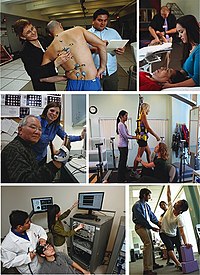
Photo from wikipedia
Background Rehabilitation is important in the first months after a stroke for recovery of functional ability, but it is also challenging, since distinct recovery trajectories are seen. Therefore, studying the… Click to show full abstract
Background Rehabilitation is important in the first months after a stroke for recovery of functional ability, but it is also challenging, since distinct recovery trajectories are seen. Therefore, studying the early changes in muscle characteristics over time (e.g. muscle strength, muscle mass and muscle volume), which are known to be associated with functional abilities, may deepen our understanding of underlying recovery mechanisms of stroke survivors. Objective This systematic review aims to describe the longitudinal changes in skeletal muscles, including muscle strength, muscle mass and muscle volume, during the first 3 months post-stroke. Methods Electronic searches were conducted in Medline, Scopus and CENTRAL. Longitudinal cohort studies or controlled interventional trials that report data about patients in the first 3 months after stroke were identified. Skeletal muscle characteristics should be measured at least twice within 3 months post-stroke by objective, quantitative assessment methods (e.g. dynamometry, ultrasound, computed tomography). Effect sizes were calculated as Hedges’ g using standardized mean differences. Results A total of 38 studies (1,097 subjects) were found eligible. Results revealed an mean increase on the paretic side for upper and lower limb muscle strength (small to moderate effect sizes), whereas muscle thickness decreased (moderate to large effect sizes). Similar, but smaller, effects were found on the non-paretic side. There were insufficient data available to draw conclusions about lean muscle mass and muscle cross-sectional area. No studies aimed at investigating distinct trajectories of the muscle changes. Conclusion Muscle strength and thickness changes during the first 3 months after stroke in both the paretic and non-paretic side. Future studies should aim to understand “how” the stroke-induced muscle strength changes are achieved. Exploring existing data from longitudinal studies, by using cluster analyses, such as pattern recognition, could add to the current knowledge-base. LAY ABSTRACT After a stroke, it is important to restore functional ability as much as possible. Studying changes in the muscles (e.g. muscle strength, muscle thickness, muscle volume) during the first months post-stroke can help to elucidate individual variations and the underlying repair mechanisms. A systematic search of the literature was performed for studies of objective quantifiable measurements of muscles at least 2 times during the first 3 months after stroke. A total of 38 studies (with in total 1,097 patients) met these criteria. Overall, an improvement in strength was measured on the paretic side for both the upper and lower limbs, but muscle thickness decreased. Similar, but smaller, effects were found on the non-paretic side. For other muscle parameters insufficient data were found to draw conclusions. Because understanding the underlying mechanism of muscle changes post-stroke can improve rehabilitation programmes, further studies should focus on why these muscle strength changes occur.
Journal Title: Journal of Rehabilitation Medicine
Year Published: 2022
Link to full text (if available)
Share on Social Media: Sign Up to like & get
recommendations!